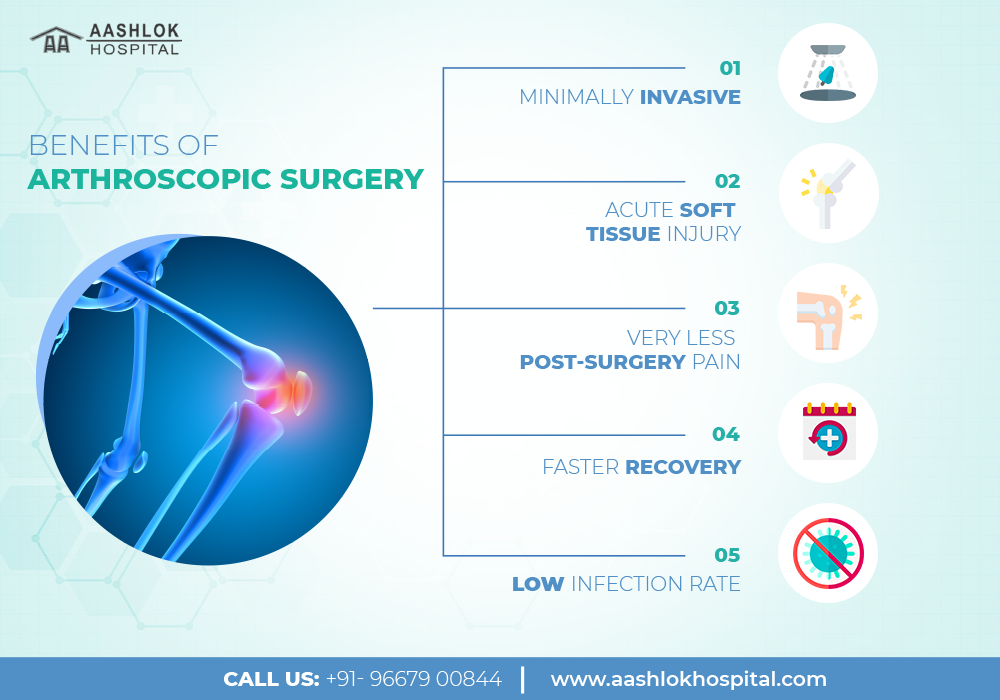Arthroscopic Surgery: Purpose, Procedure, Benefits, Cost & Recovery

Arthroscopic surgery is an orthopedic surgical procedure that is used to examine and treat the inside of a joint using a special type of camera called an arthroscope. The surgery is used both for diagnostic and treatment purposes.
Table Of Content
- What is Arthroscopy?
- What are the Types?
- Why is Arthroscopic Surgery done?
- Arthroscopic Surgery Procedure.
- How to Prepare for the surgery?
- What are the Advantages of Arthroscopy?
- What to expect after Arthroscopic Surgery?
- Cost of Arthroscopic Surgery in Delhi?
- Conclusion
What is Arthroscopy?
Arthroscopic surgery is the ultimate solution to bring an end to your chronic joint suffering. Arthroscopy is a keyhole surgery with minimally invasive procedures that allows the surgeon to treat patients suffering from acute joint conditions. This involves making a hole as small as a centimeter long and inserting a tapering flexible tube known as an arthroscope. Its fiber optic light source and the minuscule camera, paired with the magnifying lenses, help transmit the joints’ images to a video monitor. The display of the joint images through arthroscopy allows the surgeon to diagnose and treat problems of joints like knees, hips, ankles, wrists, elbows, and shoulders.
What are the Types?
Arthroscopic surgery is an advanced form of joint surgery procedure that depends on the location and the severity of the joint conditions. It helps to treat patients suffering from arthritis, baker’s cyst, carpal tunnel syndrome, etc. Aashlok Hospital has the best team of expert doctors equipped with advanced technologies to provide the best personalized care for your musculoskeletal needs.
The types of arthroscopic surgery performed by our surgeons are as follows:
1. Arthroscopic Knee Surgery
This surgical procedure is performed to relieve patients from acute pain and discomfort, repair or reconstruct knee cartilage, remove inflamed synovial tissue, treat knee sepsis, etc. An example of arthroscopic knee surgery is:
- Osteoarthritis: A medical condition that is commonly seen in patients with old age, where the gradual wearing-off of knee joint cartilage leads to pain, swelling around joints, instability, and restricted movement of the knee.
Also Read : All you need to know about – knee surgery
2. Shoulder Arthroscopy
It is a keyhole surgery procedure to examine the shoulder joint’s tissues, cartilage, bones, tendons, and ligaments and, if needed, to perform surgical procedures to repair the damage. An example of shoulder arthroscopy is:
- Shoulder dislocation: Shoulder arthroscopy is performed to treat weak shoulder joints or ligaments of patients, who suffer from repeated shoulder dislocations, despite going through strengthening and muscle rehabilitation treatments.
3. Hip Arthroscopy
This arthroscopic surgery involves a procedure where the surgeon makes one or two tiny holes to insert surgical tools to remove loose bone or cartilage around the hip or to repair the labrum or tendons. An example of hip arthroscopy is:
- Femoral-acetabular impingement (FAI)/Hip impingement: A medical condition where the patient experiences acute pain and immobility of the hip due to rubbing of the extra bony growths on the hip bones. Such abnormal growth in the bones leads to damage to the cartilage and labrum.
4. Ankle Arthroscopy
Ankle arthroscopic procedures involve surgery to treat tissues inside your ankle joints. There is minimal risk of complications. In these types of surgeries, patients are diagnosed and treated for ankle sprains, cartilage damage, and ankle impingement. An example of ankle arthroscopy is:
- Ankle impingement: It is a medical condition where the tissues in or surrounding your ankle are extremely overused due to which they become swollen and sore. This swelling causes causes pain and the stiffness restricts the mobility of the ankle.
5. Wrist Arthroscopy
This arthroscopic surgery allows your surgeons to detect problems and make repairs to the wrist without making larger cuts in the skin and tissues. It is used to diagnose and treat conditions such as wrist ligament tears, wrist fractures, and ganglion cysts. An example of wrist arthroscopy is:
- Ganglion cyst: Ganglion cysts are pea-sized lumps, filled with jelly-like fluid, that appear along the tendons or joints of wrists or hands. Ganglion cysts can be very painful if they press on a nearby nerve and tend to affect wrist mobility. In rigid cases where medications fail to cure the problem, with arthroscopic surgery the cyst can be removed, relieving the patient from the discomfort.
Why is arthroscopy surgery done?
- tikArthroscopy means to look inside a joint. The word “arthro” means joint and “skopein” means to look.
- Arthroscopy surgery is performed as an alternative to traditional open surgery in most cases.
- The procedure is done to visualize the internal structures of a joint including the bone and soft tissues and correct any prevailing issues.
- It is a minimally invasive procedure that is used by orthopedic surgeons to diagnose and treat joint conditions.
The benefits of arthroscopy encompass the following:
- Arthroscopic surgery requires only small incisions
- There is less trauma to the surrounding soft tissues
- The pain following the procedure is comparatively less
- Wound healing is faster as compared to a traditional open surgery
- The chances of infection are very low
Arthroscopic surgery in Delhi is very reasonable at Aashlok hospital.
Arthroscopic surgery procedure
In this examination /procedure, your surgeon will put you under anesthesia- it may be local ( numbing the specific area alone), regional ( specific zones of the body such as upper or lower), or general anesthesia ( where you completely fall asleep)
- Joint arthroscopy is a short stay ( one day stay )procedure in most cases.
- The surgeon makes a small incision in the skin to gain access to the joint to be examined
- Small instruments that contain a tiny lens are inserted through the incision.
- This helps to capture an image of the area and transmit it to a bigger screen.
- There is included lighting that helps to magnify and illuminate the structures inside the joint.
- The fiber optics present transmit light to the end of the arthroscope that is inserted into the joint.
- The arthroscope is attached to a camera through which the surgeon will envision the joint
- The camera captures and sets out a larger image of the same onto a bigger screen.
- This allows the surgeon to see through the joint into structures such as soft tissues that include cartilage, ligaments, and also the blood vessels and nerves, etc.
- After taking a detailed and closer look, the surgeon will determine the type of injury or infection, or inflammation that is present
- During an arthroscopy, the correction of prevailing issues is also possible using techniques specific to the joint condition
- Instruments necessary for repair of the damaged tissues are effectively chosen and handled well
- After the procedure is complete, the inserted arthroscope is taken out and the incision is closed using sutures.
- The incision is covered with a sterile dressing and allowed to heal
- Following the surgery, you may experience pain, swelling, stiffness, etc at the site of the procedure
- These must be reported on time and can be managed with prescribed medications.
How to prepare for the surgery?
- A general evaluation of your health condition will be done to ensure that you are fit for the procedure
- Blood tests and other diagnostic tests will be done
- Discuss with your doctor if you are taking any medications.
- Inform your surgeon of any illness or infection that you have had in the recent past
- You may need to stop medications that cause thinning of the blood or avoid excessive clotting.
- Inform the doctor of any bleeding disorders that you might have
- If you suspect that you might be pregnant, you must inform the surgeon
- Carry any medications that you might need to take right after the procedure
- Do not eat or drink anything about six to twelve hours before arthroscopy
- Arrange for someone to help you get home after the procedure.
What are the Advantages of Arthroscopy?
Arthroscopic surgeries are preferred by surgeons that involve less complexity due to the following reasons:
- Tiny incisions of arthroscopic surgery, lead to less exposure of soft tissues than open surgeries. This results in reduced inflammation and scarring.
- This surgical procedure helps with quicker recovery.
- Relieves you from staying for long days in hospitals post-surgery. A few surgeries like ankle arthroscopic surgery, allow the patient to return home the very day of the surgery itself.
- Arthroscopy is less pain-inducing as compared to the prolonged period of open surgery, where the patient suffers from acute pain and slowly recovers post-surgery.
Also Read : What to Expect from a Partial Knee Replacement Surgery?
What to expect after arthroscopic surgery?
- Following the procedure, you will be taken to the recovery room to be observed for a while before getting discharged
- You will be given medications to relieve the pain and stiffness in the joint. These may be felt after the effects of the anesthesia wear off
- Based on the joint involved, you may need a sling, braces, crutches, or a splint for support. Use them until your next visit to the doctor
- The dressings can be removed after a period of 5 to 10 days
- The wound will start to heal in about 1 to 2 days.
- Arthroscopic knee surgery’s complete recovery time is about 3 to 12 weeks depending on the type of procedure performed during surgery.
- Do not disturb the wound or strain the joint too much
Follow the RICE principle:
- Rest the joint
- Ice application
- Compress using a wrap or crepe bandage
- Elevate
- Follow the operating surgeon/physiotherapist’s instructions about mobilizing the joint
- Return to full normal activities may be possible after three to twelve weeks depending on the type of procedures performed during surgery.
- Take care to avoid strenuous activities until your doctor has asked you to.
- Keep the dressing dry and clean
- If you have persistent pain, swelling, or any signs of infection, consult your doctor.
Cost of Arthroscopy in Delhi
The arthroscopic surgery cost in Delhi is about Rs 55,000 to a couple of lakhs depending on the type and number of procedures performed during surgery.
The total cost of the procedure depends upon the joint involved, the extent of repair needed, your health condition, evidence of damage caused, etc.
Read More : Knee Replacement Cost in India: How to Choose the Right Surgeon and Hospital
Conclusion
The name Aashlok hospital translates to exceptional medical care in the minds of patients. Started with the sole motive of providing exceptional medical and surgical care, we stand by the same mission and values for the past 36 years. Dr. Abhishek Kumar Mishra who is in charge of Orthopaedic surgery at Aashlok has vast experience in arthroscopic surgeries. Visit us to learn how much knee arthroscopic surgery in Delhi. We have been recognized regionally and nationally for our quality of healthcare.
Housing the best doctors in each department, we stay committed to improving and attending to all your healthcare needs.
FAQs
What is the recovery time for arthroscopic surgery?
The recovery time of arthroscopy depends on the type of joint surgery, the healing strength of the patient that varies from person to person, and the recommended routine followed by the patient, post-surgery. Recovery time for knee and hip surgery is six weeks or more and the full recovery might take 6 months to 1 year. Whereas for wrist or ankle surgery it takes less time.
Can you walk after arthroscopic knee surgery?
Yes, you can walk after knee surgery, as instructed by the doctor. Normally just 1 or 2 days after the surgery you will be made to walk with support for small durations. Eventually, with the help of physiotherapy and medications, your walking capacity will grow stronger as your body slowly recover.
Is arthroscopic knee surgery a major surgery?
No, arthroscopic surgery is not considered as a major surgery. Major surgery characteristics entail serious procedures and long hospital stays. However, arthroscopic knee surgery is considered a minimally invasive surgery. It involves fewer complexities, and the patient is discharged on the very same day or within a couple of days, depending on the patient’s health and convenience.
Can I sit after knee arthroscopy?
Yes, you can sit after knee replacement, but you must be mindful not to sit in the same position for more than 40 minutes. It might result in knee stiffness. Instead, choose a firm chair with armrests to be seated in a firm and comfortable position.









